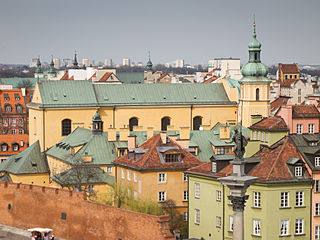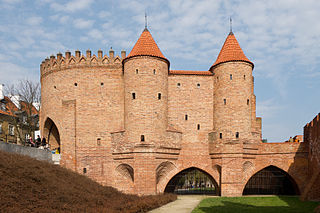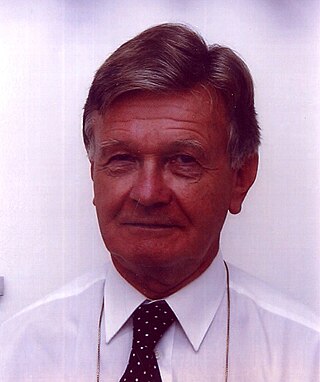
Warsaw, officially the Capital City of Warsaw, is the capital and largest city of Poland. The metropolis stands on the River Vistula in east-central Poland. Its population is officially estimated at 1.86 million residents within a greater metropolitan area of 3.27 million residents, which makes Warsaw the 7th most-populous city in the European Union. The city area measures 517 km2 (200 sq mi) and comprises 18 districts, while the metropolitan area covers 6,100 km2 (2,355 sq mi). Warsaw is an alpha global city, a major cultural, political and economic hub, and the country's seat of government. It is also capital of the Masovian Voivodeship.

Masovian Voivodeship, also known as Mazovia Province and Mazowsze Province, is a voivodeship (province) in east-central Poland, containing Poland's capital Warsaw.

Lublin is the ninth-largest city in Poland and the second-largest city of historical Lesser Poland. It is the capital and the centre of Lublin Voivodeship with a population of 336,339. Lublin is the largest Polish city east of the Vistula River and is about 170 km (106 mi) to the southeast of Warsaw by road.

The Great Orchestra of Christmas Charity is the biggest, non-governmental, non-profit, charity organization in Poland raising money for pediatric and elderly care. The GOCC Foundation holds American Heart Association certification to provide courses in CPR and AED, and for the use of high technology for medical lifesaving. The GOCC aims to support health care in Poland by purchase of state of the art medical equipment for Polish hospitals and clinics and by establishing and running six medical programmes and one educational programme. The foundation supports pediatric and geriatric wards, furnishing them in both complex medical devices such as MRI scanners, and providing long-term care units with anti-bedsore mattresses and beds.

The Medical University of Warsaw is one of the oldest and the largest medical schools in Poland. The first academic department of medicine was established as far back as two centuries ago in 1809. It is considered to be one of the most prestigious and reputable schools nationally for the medical sciences, partly due to its affiliation with a number of large hospitals in Poland.

Ujazdów Castle is a castle in the historic Ujazdów district, between Ujazdów Park and the Royal Baths Park, in Warsaw, Poland.

The Krasiński Palace, also known as the Palace of the Commonwealth, is a reconstructed Baroque palace in Warsaw, Poland, on Krasiński Square. Initially erected between 1677 and 1683 for the powerful Krasiński family, it was heavily damaged during World War II and rebuilt in the mid-20th century.

Powszechny Zakład Ubezpieczeń Spółka Akcyjna, also known as PZU SA is a publicly traded insurance company, a component of the WIG30 stock market index and Poland's biggest and oldest insurance company. PZU is headquartered in Warsaw and is the largest financial institution in Poland. It is also the largest insurance company in Central and Eastern Europe.

St. Martin's Church is a church in Warsaw, Poland. It is located on ulica Piwna in the Polish capital's Old Town.

The Robert Wood Johnson University Hospital (RWJUH) is a 965-bed hospital with campuses in New Brunswick, and Somerville, New Jersey, and serves as a flagship hospital of RWJBarnabas Health.

For health issues in Iran see Health in Iran.

The Brühl Palace, formerly known as Sandomierski Palace, was a palatial residence standing at Piłsudski Square, in central Warsaw, Poland. It was one of the largest palaces and one of the finest examples of rococo architecture in pre-World War II Warsaw.
Parkview Health System, founded in 1878 as Fort Wayne City Hospital is a network of 14 community hospitals and nearly 300 physician offices in northeast Indiana and northwest Ohio. The not-for-profit Parkview Health System is the region's largest employer with more than 16,000 co-workers. Parkview Physicians Group is also part of the Parkview Health, and includes nearly 1,200 providers in more than 45 specialties.

Health care in Poland is insurance based, delivered through a publicly funded health care system called the Narodowy Fundusz Zdrowia, which is free for all the citizens of Poland provided they fall into the "insured" category. According to Article 68 of the Polish Constitution everyone has a right to have access to health care. Citizens are granted equal access to the publicly funded healthcare system. In particular, the government is obliged to provide free health care to young children, pregnant women, disabled people, and the elderly. However, private health care use is very extensive in Poland. Patients who are uninsured have to pay the full cost of medical services. According to a study conducted by CBOS in 2016, out of 84% patients taking part in the survey, 40% declared use of both private and public health services, 37% use only public health care, and 7% use only private health services. 77% of all responders declared using private health care is caused by long waiting for public health care services.

PGE Polska Grupa Energetyczna S.A. is a state-owned public power company and the largest power producing company in Poland. PGE is listed on the Warsaw Stock Exchange and is a constituent of the WIG30 index.

The architecture of Warsaw has influenced and reflected the history of Polish architecture. The city of Warsaw features prominent buildings in a variety of styles by many important architects. Warsaw's palaces, churches and mansions display a richness of color and architectural details.

The Children's Memorial Health Institute is the largest and best-equipped institute of paediatric healthcare in Poland. Located in Warsaw and directly subordinate to Poland's Ministry of Healthcare, it is also one of leading teaching hospitals in Poland.

Waldemar Lech Olszewski was a Polish lymphologist. His main area of study is the human lymphatic system. Clinical and research interests comprise vascular surgery, transplantation, physiology and surgery of the lymphatic system and immunology. He discovered fundamental processes in human tissues connected with function of the lymphatic system.
Europa Plus was a pro-European centre-left coalition of parties in Poland, formed to contest the 2014 European Parliament election. The alliance described itself as a "modern centre-left formation".


















